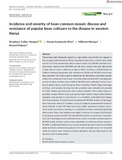Incidence and severity of bean common mosaic disease and resistance of popular bean cultivars to the disease in western Kenya
Date
2020-07-01Author
Mangeni, Bonphace Collins
Were, Hassan Karakacha
Ndong'a, Millicent
Mukoye, Benard
Metadata
Show full item recordAbstract
The common bean (Phaseolus vulgaris) is a high protein crop and the main legume in the cropping system of western Kenya. Despite its importance, common bean yields are low (<1.0 t/ha) and declining. Bean common mosaic virus (BCMV) and bean common mosaic necrosis virus (BCMNV) are the most common and most destructive viruses and can cause a yield loss as high as 100%. In Kenya, a limited number of cultivars and exotic genotypes with resistance to BCMV and BCMNV strains have been reported. This study sought to determine the distribution and screen popular cultivars for resistance to the viruses. In October 2016 and May 2017, two diagnostic surveys for bean common mosaic disease (BCMD) were conducted in seven counties of western Kenya namely Bungoma, Busia, Homa Bay, Nandi, Vihiga, Kakamega and Siaya. Leaf samples showing virus-like symptoms were collected and analysed by ELISA. Sixteen popularly grown bean cultivars together with cowpea (Vigna unguiculata), soybean (Glycine max), green grams (Vigna radiata) and groundnut (Arachis hypogaea) were planted in a greenhouse in a completely randomized block design with three replicates. The plants were inoculated with BCMNV isolate at 3-leaf stage. Data were taken weekly for 3 weeks on type of symptoms expressed and number of plants infected. In total, 270 bean farms were visited. Symptoms of mosaic, downward curling, local lesions, stunting or a combination of these were observed during both surveys. Mean virus incidence was higher in the short rain season (50.2%) than in the long rain season (35.6%). The mean BCMD severity on a scale of 0–3 was highest (2.3) in Kakamega County and lowest (0.5) in Siaya. On variety resistance tests to BCMNV isolate, 10 bean cultivars were susceptible, four tolerant and two resistant. BCMNV is widely distributed across counties probably because of use of uncertified seeds by farmers and inoculum pressure from seed and aphid vector. For improved yields of common bean, farmers should be advised to plant certified seeds for all legumes in the cropping system.
URI
https://doi.org/10.1111/jph.12928https://onlinelibrary.wiley.com/doi/epdf/10.1111/jph.12928
http://ir-library.mmust.ac.ke:8080/xmlui/handle/123456789/2233
Collections
- Gold Collection [1026]

